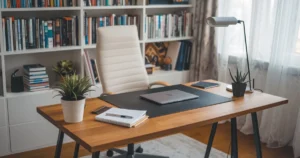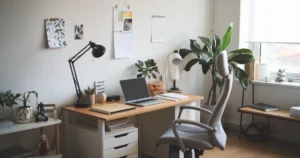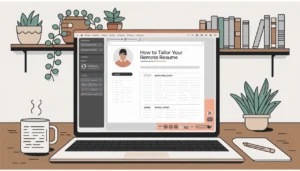An arranged Home Office Setup is critical in contemporary times as remote work lifestyles tend to increase. It separates the work and personal lives of a person. This would also create focus and efficiency for the person by improving concentration, reducing distractions, and achieving success in remote endeavors.
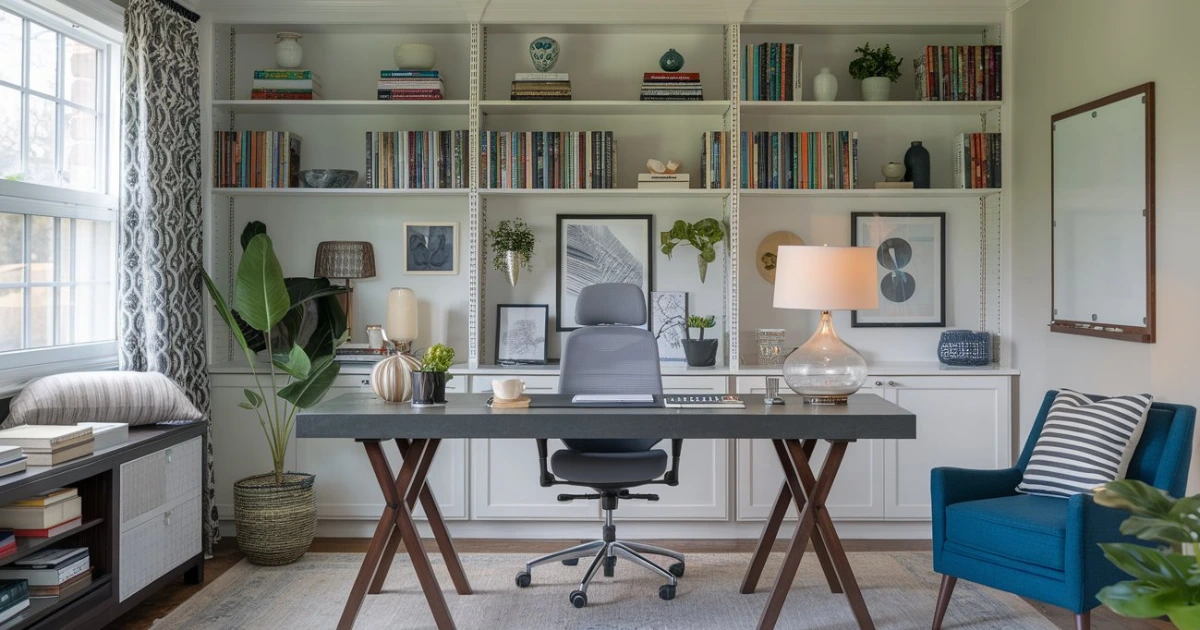
Space for One Defined Space
A designated workspace is the very anchor of a successful home office. Defining one area as a work place will enable you to mentally and physically prepare yourself for focused work while cutting out distractions. This workspace should be set up so that it is free from clutter and interference, allowing you to reserve your energy for tasks at hand.
Identify or Design an Suitable Workspace
Identify a quiet space: Find a room or a corner of your home that is somewhat undisturbed by noise and foot traffic.
Natural light: Find a spot with natural daylight if possible-this contributes so much to your mood and energy level.
Designate a clear boundary: Define the boundary that separates your workspace from the rest of your home by erecting physical or visual demarcations. Sometimes, it’s that simple-say, move that partition, change up the color scheme, or close a door.
Ergonomic Furniture
Pay the money out to make a financial investment in ergonomic furniture in order to minimize discomforts and pains in a day-long work session. Ergonomic chairs, desks, and monitors are designed to encourage natural postures, and such postures would result in less pressure being exerted on muscles and joints.
Recommendations on Comfortable and Supportive Furniture
Chair: Chairs with height adjustment facilities are perfect for chair comfort-ability when having to sit long periods and work for long times. The seat should be firm but at the same time comfortable to sit on and also the proper presence of a backrest, supported to lower back
Desk: The desk at which you sit should be of size that can fit your chair. Your feet should reach the ground when you sit because your workplace is considered to be the prime emphasis of your furniture height. It should be large enough to be able to carry your computer, your keyboard, and a couple of other stuff you may need on the desk.
Monitor: Position your monitor directly in line with your eyes and not farther than an arm’s length from your head. Eye strain and neck pain are reduced.
Organization and Clutter Control
The cluttered workspace greatly affects one’s productivity and mental acuteness. Organization of your workspace will make it well set up and appreciated in the way you want to have it.
Effect of Clutter on Productivity
Increased stress: One does feel more stressed and overwhelmed by clutter.
Minimalized focus: A disorganized room diminishes your ability to concentrate and keep a task on hand.
Negative attitude: A disorganized workspace is also said to deteriorate your mood in general and even motivation.
How to Sustain the Cleanliness and Available Space at Your Workplace
Get rid of unnecessary clutter: Get rid of things that have no significant use and only keep them if they are a necessity in your working time.
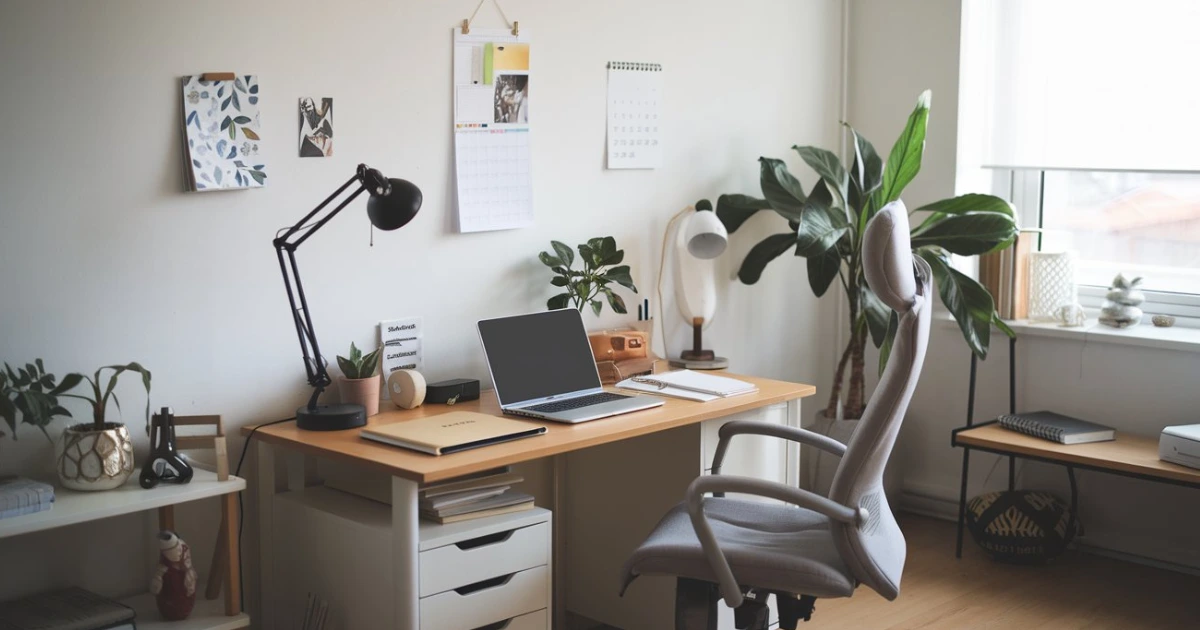
Make use of space storage: Arrange your stuff on shelves and drawers and other organizers, your supplies as well as papers.
There should be a need for the “one in, one out” principle: For each old item you take from the workspace, bring in something new so that there will be no clutter.
Lighting and Temperature
There must be appropriate lighting and temperature in the working area. Proper lighting reduces eye strain and fatigue, while comfortable temperature can enhance your mood and concentration.
Proper Lighting and Temperature Is an Important Factor in Enabling the Good Working Environment
Lighting: It is always the preference to use natural light, but if it can’t be helped, a combination of overhead lighting and task lamps should be used to provide the necessary illumination.
Temperature: The temperature should be set between 65-75 degrees F (18-24°C). Keep away from extreme temperatures that would make you feel uncomfortable or lethargic.
Technology and Equipment
Having the right technology and equipment is important to work efficiently. A reliable computer, a stable internet connection, and such other necessary peripherals are some of the crucial accompaniments to any well-equipped home office.
Basic Technology and Equipment for the Home Office
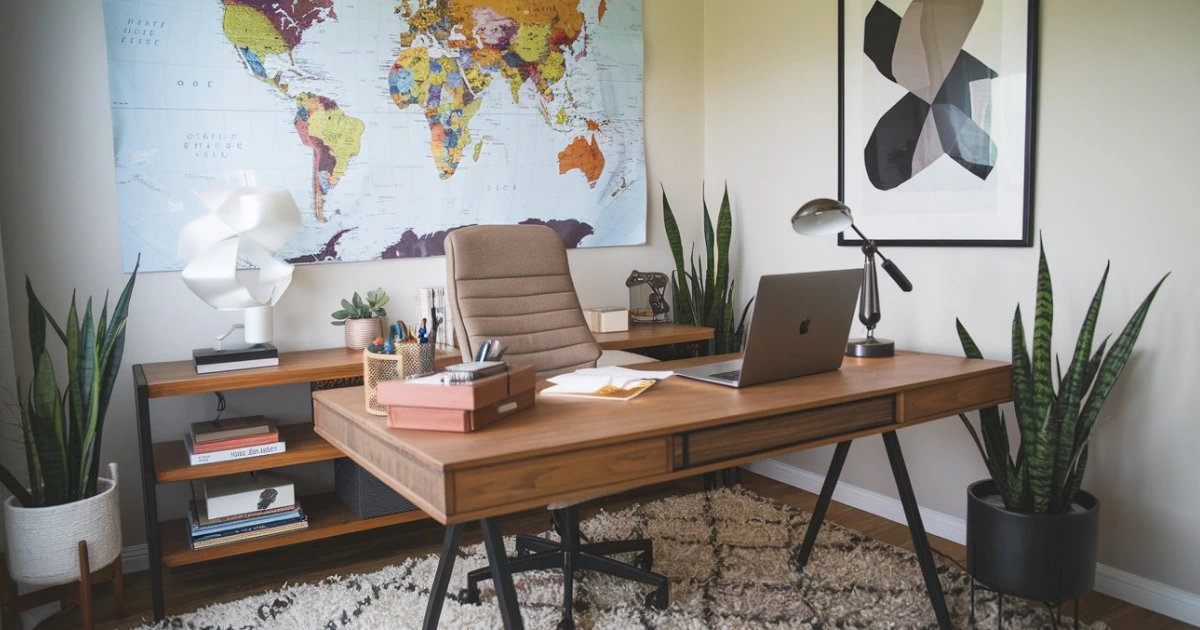
Personal Computer: You need a computer with enough processing power to perform all your job work.
Internet: You need high speed internet connectivity, as most of the required information is available online. High-Speed connectivity and also for usual and work-related communications.
Peripherals: For comfort and ease of working, you need a good keyboard and mouse. A printer or scanner may be necessary, as well as noise cancellation headphones.
Recommendations for Selection of the Right Tools
Consider your needs: Determine the needs you must do your job so you can get the best appropriate technology and equipment for your home office.
Quality over quantity: It is better to invest in quality products that are reliable and durable.
Keep updated: Only to be fit for the best execution of both hardware and software shall keep them updated.
Noise Reduction and Privacy
A quiet and private workspace is hence an important factor against distractions and keeping focus. Strategies to minimize noise levels and creating a private space might raise levels of productivity and concentration.
Why you need a quiet and private workspace
Minimize distractions: Noises have been proven to distract you from concentrating on anything or doing tasks as required.
Improved concentration: You are more able to focus on your work in a quiet atmosphere.
Better privacy: A private room covers your personal information and ensures that secrecy is maintained.
Ways to Minimize Noise and Disturbances
Noise cancellation headphones: In case you can get good noise cancellation headphones.
Create a real wall of separation: Use a partition, curtain or door to wall out the noisy areas far from your workspace.
Plan quiet hours: You can do your work during less busy hours of the day when interference is limited
Other Productivity Hacks
Establish a Routine
A consistent daily routine will go a long way in improving productivity and focus. By setting up a routine, you will be able to establish predictability and, by the same token, eliminate decision fatigue.
Advantages of Having a Daily Work Routine
Efficiency: A routine allows you to prioritize tasks and even gives you time allocation.
Improved concentration: The more rigid the schedule is, the lesser distraction it will present, and you will maintain work on task.
Greater productivity: A schedule can reduce anxiety and stress.
How to Set a Busy-Friendly Calendar
Identify when you are most productive: Find the times when you feel you are most sharp and alert, and you schedule all your most demanding tasks at those times.
Make realistic goals: Divided among several brisk segmented tasks rather than trying to take on too much.
Prioritize your activity: Use to-do lists or any available time management apps to prioritize what you have to do according to its importance and urgency.
Build in breaks: Schedule breaks and segments of non-productive time during the workday to rest and re-energize.
Taking Breaks to Combat Burnout
Regular breaks must be taken to avoid burnout and maintain productivity. Short breaks can help you maintain a state of focus, reduce stress, and avoid mental fatigue.
Why Regular Breaks and Self-Care Matter
Attention: Taking breaks enhances alertness and attention about tasks.
Reduces stress: Break times reduce the feeling of getting burned-out.
Enhances creativity: Break times allow the mind to wander and conceptualize ideas.
Prophylactic Strategies Burnout
Mindfulness: Engage in mindfulness techniques, either meditation or deep breathing, to reduce stress and improve attentiveness.
Sleep right: Most people require 7-9 hours of good sleep each night.
Exercise regularly: Overall regular exercise may help reduce stress, elevate mood, and increase energy.
Define boundaries: Establish clear separations of work and personal time to prevent burnout.
Customize Your Environment
Adding personal touches to your home office can make it more fun and inspiring. A personalized workspace by reflecting your personality, making you all the more creative, and giving a good feel can really change things.
Impact of Personal Touches on Motivation and Productivity
Greater motivation: The person feels highly motivated towards his work being associated with and connected to a personal space.
Good mood: Objects that please the heart make the mind feel happier and far from stress.
Increased creativity: A creative and inspiring workspace can ultimately inspire new ideas and innovation.
Ideas for Adding Personal Elements to Your Home Office
Add things that inspire you: Hang some artwork, photos, or motivational quotes that inspire you.
Plant life: Bring some plants to work, which shall clean the air and add that touch of nature.
Succulent and comfortable furniture: Prefer furniture that serves its purpose well while looking stylish.
Make it your space: Add one favorite mug or soft blanket at the perfect spot so you can feel it
Vision board: The vision board is one of the most creative ways to see better and get motivated regarding the goals set.
Conclusion
That is to say, this calls for great care in coming up with a productive home office setup that may be helpful in boosting efficiency in the modern remote workplace. That is by utilizing the ideas presented in this post, which entail establishing a specific workspace, ergonomic furniture, organized atmosphere, appropriate lighting and temperature levels, applicable technology, and noise reduction. Follow the tips and suggestions outlined here to transform your home office into a thriving workspace that supports your professional goals and enhances your well-being as an overall individual.
FAQs for Creating a Productive Home Office Setup
Q: What is the best space to locate a good home office?
A: Consider a room in your home that is quiet and undisturbed. Consider natural light, privacy, and ability to create a distinct separation between work and personal space.
Q: What sort of furniture do I recommend for the home office?
A: Use ergonomic equipment, such as height-adjustable chairs, standing desks, and monitors that can be set up so they are at a comfortable distance, to accommodate your body’s natural positions and minimize discomfort.
Q: How should I prepare my home office to be clutter-free?
A: Make time to declutter; be prepared with storage solutions, such as shelves or compartments, to maintain an organized and clutter-free workspace. A “one in, one out” policy is also helpful.
Q: What is the suggested lighting and temperature for a home office?
A: Utilize natural lighting from windows or use overhead lighting and task lamps. Temperature should be set at 65-75°F (18-24°C).
Q: What will be the most essential apparatuses and technologies to be used in a home office?
A: To optimally equip a home office, it is necessary to have available a computer of good quality, internet access, and basic peripherals, including keyboard, mouse, printer, and scanner.
Q: How would you minimize distractions and noise in your home office?
A: Invest in noise-canceling headphones, put up a physical barrier, and do tasks when the house is quiet.
Q: How do I set up a daily routine to get things accomplished in my home office?
A: If you know where you work best, then successful goal setting, prioritization, and making space for regular breaks to refresh keep you from getting burned out.
Q: How can you avoid burnout working from your home?
A: Be more mindful, sleep well, exercise, and differentiate time for work and personal life
Q: What can I do to personalize my home office to make it more inspiring?
A: Personalize with inspirational stuff, add greenery, use nice yet fashionable furniture, and your own touches like photographs or your favorite mug.
Q: What else are some tips for remaining focused and productive in a home office?
A: The Pomodoro Technique, time blocking, the Eisenhower Matrix, and others. Try all of them and see which one suits you best.

